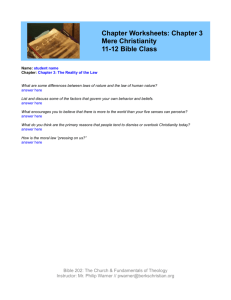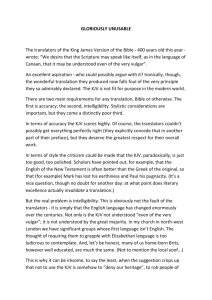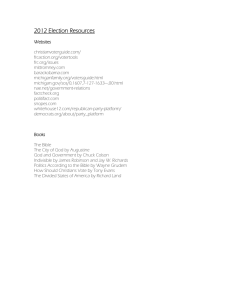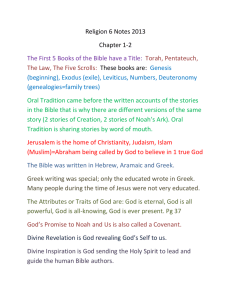Bible TRANSLATION
advertisement
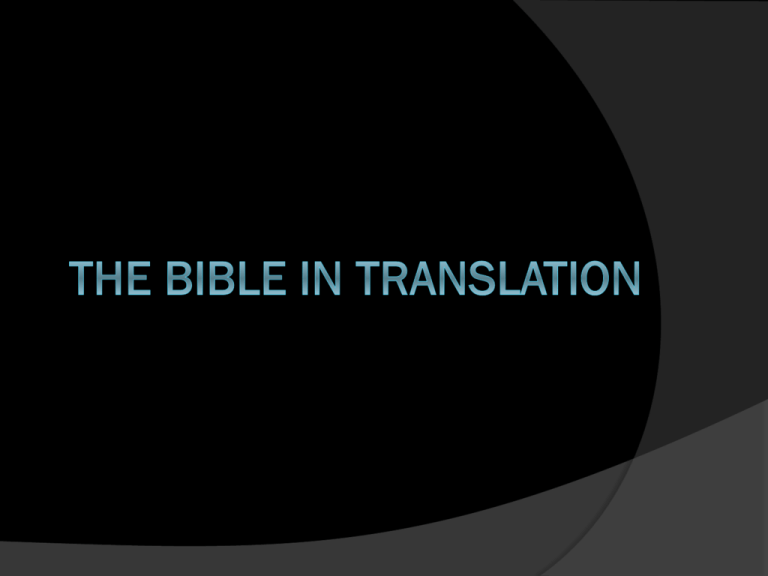
“By the seventh month the people of Israel were all settled in their towns. On the first day of that month they all assembled in Jerusalem, in the square just inside the Water Gate. They asked Ezra, the priest and scholar of the Law which the LORD had given Israel through Moses, to get the book of the Law. So Ezra brought it to the place where the people had gathered---men, women, and the children who were old enough to understand. There in the square by the gate he read the Law to them from dawn until noon, and they all listened attentively.” (Nehemiah 8:1-3) “They gave an oral translation of God’s Law and explained it so that the people could understand it. When the people heard what the Law required (when they understood the meaning), they were so moved that they began to cry. So Nehemiah, who was the governor, Ezra, the priest and scholar of the Law, and the Levites who were explaining the Law told all the people, ‘This day is holy to the LORD your God, so you are not to mourn or cry.’” (Nehemiah 8:8-9) What is “the Bible”? 66 Books: 39 Old Testament books – Hebrew, some Aramaic 27 New Testament books – Greek “The Bible” in Jesus’ day The Greek translation of the Hebrew OT the Septuagint, LXX (285 – 246 B.C.) The first translation of the Hebrew “All Scripture is inspired by God…” (1 Timothy 3:16) All OT quotes in the NT are from the LXX To this day it is the authoritative biblical text of the OT for the Greek Orthodox church Christian Bible accepted the LXX sequencing, not the Hebrew “The Bible” in Jesus’ day Samaritans Lived in the former northern kingdom Only considered the 5 books of Moses (the Pentateuch) to be “the Bible” “…he will send you a prophet like me from among your own people, and you are to obey him.” (Deuteronomy 18:15) “The Bible” in Jesus’ day Sadducees Only considered the 5 books of Moses (the Pentateuch) to be “the Bible” Did not believe in the resurrection or angels, etc. “The Bible” in Jesus’ day Essenes A collection of the books of Moses, the prophets, Psalms, and apocryphal works Dead Sea scrolls “The Bible” in Jesus’ day Pharisees Essentially held to the same 39 books of the OT as modern Christianity The Catholic Bible Includes the apocrypha Considered “2nd class” books (“deuterocanonical”) but yet…. What happens to “the soul” at the resurrection? (“The Book of Wisdom”) Muratorian fragment (canon) Discovered in Milan (1730’s) Dated late 2nd century (170 A.D.) A list of all the works that were accepted as canonical. Added the 4 gospels, and the rest of the NT (except Hebrews, James, Peter) Rejected the gnostic writings Accepted certain apocryphal writings (Book of Wisdom, etc.) Eusebius canon (bishop of Caesarea) 4th century (325 A.D.) 27 books of the NT Greek Septuagint (OT) Apophryphal OT writings Athanasius of Alexandria Eliminated apocryphal books (367 A.D.) Specified the 27 books of the NT Council of Carthage (397 A.D.) Manuscripts We have no original composition of any part of the Bible! Copies of copies of copies of copies Masoretes added vowels between 500700 A.D. Chapters added 1240 A.D. Verses added 1551 A.D. Ancient versions A tribute to the success and spread of Christianity! Aramaic Targums Arabic (10th century) Syriac (Syria, Iraq, southeast Turkey) – a branch of Aramaic Coptic (Egypt) Latin (Western church) Gothic (Eastern Germanic people) - extinct Slavonic Anglosaxon (7th, 8th century) Frankish Greek (Eastern church) Armenian (Black sea, turkey, Syria) Georgian (North of Armenia – Black/Caspian sea) Ethiopian Persian Chinese The Latin Vulgate (405 AD) Multiple very poor quality Latin translations pre-Jerome Jerome (340-422 AD) Jerome A scholar of Greek, Latin, and some training in Hebrew Translated in Latin from the Greek and Hebrew Did not want to include the apocryphal works For that time, a great translation For almost 1,000 years (6th-16th century) the Vulgate was the recognized text of Scripture Justification Sanctification Expiation Propitiation Salvation Reconciliation Jerome to his detractors “two-legged asses” “yelping dogs” People who “think that ignorance is identical with holiness” Pope Gregory VII (1073-1085) “For it is clear to those who reflect upon it that not without reason has is pleased Almighty God that holy scripture should be a secret in certain places lest, if it were plainly apparent to all men, perchance it would be little esteemed and be subject to disrespect; or it might be falsely understood by those of mediocre learning, and lead to error.” English Bible pre-KJV John Wycliffe (1330-1384) Anticipated the reformation The Bible is the sole criterion of doctrine, not the church or the pope The authority of the pope is not found in scripture Handwritten translation from the Latin ○ 1382 – literal and “wooden” ○ 1388 – more readable ○ The only English Bible until 1526 Wycliffe Bible: Jesus spoke Aramiac Greek Latin English About 180 copies survive The Reformation Constantinople fell (1453 A.D.), Greek scholars came west Plato The Reformation Printing press, Guttenberg (1398- 1468) First printed Hebrew OT – 1488 First published Greek NT – 1516 The Bible translated from the original languages – “the peoples book” French Bible (1530) Spanish Bible (1569) Dutch Bible (1637) Swedish (~1600) Czech (1579) Finnish (1598) Hungarian (1541) Polish (1541) German (1534) English (1525) The reformation Tension between scholar and priest The scholar had better versions Tension between priest and the common person The common person had better versions The authority of medieval Catholicism challenged The reformation Wealth/prosperity of the church vs. the humility of Christ Sacraments Indulgences Need for a priest/saint “in between” Purgatory Monasticism Transubstantiation German Bible – Luther (1534) From the Greek and Hebrew “Sola scriptura” (the Bible alone) Hebrews, James, Jude, and Revelation of lesser quality Preface to the NT (1522) – James is “a letter written in straw” Revelation – “I can in no way detect that the Holy Spirit produced it” Rejected all forms of allegory as a means of understanding scripture English Bible’s pre-KJV William Tyndale THE father of the English Bible Educated at Oxford and Cambridge in Greek and Hebrew English version, based on the Greek and Hebrew NT completed in 1525 “If God spare my life, ere many years, I will cause a boy that driveth the plough to know more of the Scripture than thou dost.” Tyndale – “A great linguist!” “Tush, ye shall not die.” (Genesis 3:4) “The Lorde was with Joseph, and he was a luckie felowe.” (Genesis 39:2) “80% or more of the English Bible down to the Revised Version has been estimated to be his…” Toxic foot notes “666” – clearly the pope “Oh, abominable pope with all his idols.” Breaking someone’s neck: “This is a good text for the pope.” “Lord, open the king of England’s eyes” Miles Coverdale (1535) – first printed edition NT based on Tyndale’s translation OT based on the Vulgate Matthew’s Bible (1537) Pseudonym: John Rogers Tyndale (and Coverdale) revision Burned alive in 1555 – “Rogers died with such composure that it might have been a wedding” Richard Taverner’s Bible (1539) The Great Bible (1539) – the largest Bible (15”x10”) A revision of the Coverdale and the Matthew’s Bible “Long live the King!” Edmund Beck’s Bibles (1549, 1551) “In the same way you husbands must live with your wives with the proper understanding that they are more delicate than you. Treat them with respect...” (1 Peter 3:7 – GN) “And if she be not obedient and healpeful unto hym: endeavoureth to beate the feare of God into her heade…” The Geneva Bible (1560) Persecution in England, led to Protestant’s fleeing to Geneva, Switzerland The names of the translators were hidden (William Whittingham) From 1560 to 1616 a new edition was published every year! ○ The Bible of Shakespeare, John Bunyan, Mayflower captain, Puritan pilgrims, King James The most popular English Bible for almost 200 years! The Geneva Bible (1560) The first English Bible to have chapters and verses “Breeches” Bible – “They sewed figge-tree leaves together and made themselves breeches” (Genesis 3:7) Marginal notes: ○ “the angel of the bottomless pit” = the pope ○ King James decision in 1604 for a new translation The Bishop’s Bible (1558) Revisers were bishop’s Displaced the Great Bible in churches Less popular than the Geneva Rheims-Douay Bible (1582-1610) An English version for Catholics A translation from the Latin Vulgate** (“KJV”) Footnotes ○ Protestant “hereticks” ○ 666 “You cannot be a slave of two masters; you will hate one and love the other; you will be loyal to one and despise the other. You cannot serve both God and money.” (Matthew 6:24 – GN) Footnote: “Two religions, God and Baal, Christ and Calvin, Masse and Communion, the Catholike Church and Heretical Conventicales.” The King James Bible (1611) 1604 – Committee of 50 “learned men” (the model to follow) Lancelot Andrews – “had he been present at the tower of Babel, he could have served as interpreter general.” Rules: “The Bishops’ Bible was to be followed with ‘as little altered as the truth of the original will permit’ and to include other translations – ‘Tindoll’s Matthew’s, Coverdale’s, Whitechurch’s (the Great Bible), and Geneva.” Marginal notes only to explain the Greek and Hebrew! Italics used Preface The KJV is a REVISION, not a new translation (although they did have the Greek and Hebrew) The KJV is really a revision of the Bishop Bible....which was a revision of the Great Bible, which was a revision of Coverdale and Tyndale. The "credit" of the KJV in terms of vocabulary should go to Tyndale, the expression and harmony to Coverdale, the scholarship and accuracy to the Geneva Bible. The first printed version of the KJV contained about one error for every 10 pages - some of these errors, due to printing, persist in the current KJV today. Matthew 23:34 “Ye blind guides, which strain at a gnat, and swallow a camel” (KJV) should have been printed, “strain out a gnat.” 1631 printed edition of Exodus 20:14: "Thou shalt commit adultery"! “Ask, and it shall be given you; seek, and ye shall find; knock, and it shall be opened unto you: For every one that asketh receiveth; and he that seeketh findeth; and to him that knocketh it shall be opened.” (Matthew 7:7,8 – KJV) “Our Father which art in Heaven, Hallowed be thy name…” (Matthew 6:9 - KJV) Weakness: The textual basis for the KJV is inadequate. NT: Textus Receptus (Erasmus of Roterdam) – 1469-1536 ○ Mediocre manuscripts, the earliest from the 10th century! ○ Erasmus did not have a complete Greek NT text (Revelation) – using the Latin Vulgate he finished it into Greek!! OT: A partially corrupt Erasmus Greek text ○ Codux Alexandrinus (5th century) not available Many errors in the book of Job, Isaiah But, the best Bible to date Weakness: Knowledge of Hebrew largely derived from the Bible Less knowledge of the Greek The English language has changed: “Verily I say unto thee, Thou shalt by no means come out thence, till thou hast paid the uttermost farthing.” (Matthew 5:26 – KJV) “Lest haply if they of Macedonia come with me, and find you unprepared, we (that we say not, ye) should be ashamed in this same confident boasting.” (2 Corinthians 9:4 – KJV) “From which some having swerved have turned aside unto vain jangling…” (1 Timothy 4:6 – KJV) “And Jonathan stripped himself…to his girdle.” (1 Samuel 18:4 – KJV) ERV (1881) ASV (1901) RSV (1952) NASB (1963 – 1995) NKJV (1982) NRSV (1990) “To many people, the KJV sounds like the Bible because it is different than our modern English. It is old and therefore seems to be authoritative…and other Bible’s just don’t sound right… “Most Bible translators greatly respect the KJV for what it is and what it was. But the KJV can’t be used in modern translation work for the simple reason that its language and its text are out of date.” (Essential Guide to Bible Versions, Philip Comfort, pages 159, 160) Between the KJV and the RV (1870) Private versions: Edward Harwood’s NT (1768) Charles Thomson’s Bible (1808) Noah Webster’s Bible (1833) ○ Found 150 words and phrases in the KJV to be erroneous or misleading. Almost all used by the RV. Julia E. Smith’s Bible (1876) The hunt for older/better manuscripts – “the Greek manuscripts had shown beyond question that the KJV was based upon a Greek text that contained the accumulated errors of fifteen centuries of manuscript copying.” (The Bible in Translation, pg. 100 – Metzger) Today, 5,000 Greek NT manuscripts that date back prior to the 5th century! Mid-1800’s Constantin Von Tischendorf St. Catherine’s Monastery (1844) 43 leaves in the trash - - virtually an entire Greek translation of the NT The entire Old and New Testament dated as early as 340 AD In the British Museum since 1933 P52 (1920) P52 The Oldest known fragment of the NT – 125 A.D. John 18:31-33; 37,38 – “Are you the King of the Jews?... I was born and came into the world for this one purpose, to speak about the truth….What is truth?” Shot down several theories! Dead Sea scrolls – 1947,1948 Scrolls found in a cave by the Dead Sea, dated 100 BC – 100 AD (? 70AD) 1,000 years earlier than any of the Masoretic manuscripts! Every OT book except Esther is represented, LXX, Targums of the OT… Surprisingly few differences from the Masoretic manuscripts, despite 1,000 years of copying! – “This shows that Jewish scribes for over a millennium copied one form of the text with extreme fidelity.” “No one has seen God at any time. The only begotten Son, who is in the bosom of the Father, He has declared Him.” (John 1:18 – NKJV) “No one has ever seen God. The only Son, who is the same as God and is at the Father's side, he has made him known.” (John 1:18 – GN) KJV still dominated English Revised Version (18701895) “And they did eat, and were all filled; and there was taken up that which remained over to them of broken pieces, twelve baskets.” (Luke 9:17) American (1901) Standard Version NKJV (1982) Updated language but still…. “day of his espousals” (Song of Songs 3:11) “dandled” (Isaiah 66:12) Inferior edition of the Greek text “In these lay a great multitude of sick people, blind, lame, paralyzed, waiting for the moving of the water. For an angel went down at a certain time into the pool and stirred up the water; then whoever stepped in first, after the stirring of the water, was made well of whatever disease he had. Now a certain man was there who had an infirmity thirty-eight years.” (John 5:3-5 – NKJV) “Few textual scholars today would accept the authenticity of any portion of vv. 3b–4, for they are not found in the earliest and best witnesses.” Biblical Studies Press. 2003; 2003. The NET Bible Notes . Modern speech versions Discovery of large numbers of Greek papyri “It became clear that the NT documents were written in a plain, simple style to meet the needs of ordinary men and women. Should they not then be translated into the same kind of English?” (The Bible in Translation, pg. 105, Metzger) The Twentieth Century NT (1901,1904) “Drink ye all of it.” (KJV, RV) “Drink from it, all of you.” Weymouth’s NT in Modern Speech (1903) Moffatt’s Translation of the Bible (1913,1924-5) Smith and Goodspeed’s American Translation (1923,1927) “I have said all this to you in figures, but a time is coming when I shall not do so any longer, but I will tell you plainly about the Father. When that time comes you will ask as my followers, and I do not promise to intercede with the Father for you for the Father loves you himself…” (John 16:25,26 Goodspeed) Revised Standard Version (1952) New Jerusalem Bible (1966) The first Catholic Bible in English translated from the Greek and Hebrew New English Bible (1970) Asphodel, lapis, lazuli, panniers, reck, ruffled bustard, runnels of water, and stook New Revised Standard Version (1990) Revision of the ASV, using best Hebrew and Greek sources “…the most up-to-date textual studies of the NT” (Essential Guide to Bible Versions, Comfort, page 175) New International Version (1978) Somewhere in between a “literal” translation and a free, modern-speech edition Since 1987 has outsold the KJV “I gave your ancestors no commands about burnt offerings or any other kinds of sacrifices when I brought them out of Egypt.” (Jeremiah 7:22 – GN) “For when I brought your forefathers out of Egypt and spoke to them, I did not just give them commands about burnt offerings and sacrifices…” (Jeremiah 7:22 – NIV) New American Standard Bible (1971,1995) “Literal” translation J.B. Phillip’s Version (1972) “Of all modern English translations of the NT epistles, this is one of the best – perhaps actually the best – for the ordinary reader.” (The English Bible, pg.223, Bruce) “If I speak with the eloquence of men and of angels, but have no love, I become no more than blaring brass or crashing cymbal. If I have the gift of foretelling the future and hold in my mind not only all human knowledge but the very secrets of God, and if I also have that absolute faith which can move mountains, but have no love, I amount to nothing at all. If I dispose of all that I possess, yes, even if I give my own body to be burned, but have no love, I achieve precisely nothing. This love of which I speak is slow to lose patience - it looks for a way of being constructive. It is not possessive: it is neither anxious to impress nor does it cherish inflated ideas of its own importance. Love has good manners and does not pursue selfish advantage. It is not touchy. It does not keep account of evil or gloat over the wickedness of other people. On the contrary, it is glad with all good men when truth prevails. Love knows no limit to its endurance, no end to its trust, no fading of its hope; it can outlast anything. It is, in fact, the one thing that still stands when all else has fallen. For if there are prophecies they will be fulfilled and done with, if there are ‘tongues’ the need for them will disappear, if there is knowledge it will be swallowed up in truth. For our knowledge is always incomplete and our prophecy is always incomplete, and when the complete comes, that is the end of the incomplete. When I was a little child I talked and felt and thought like a little child. Now that I am a man my childish speech and feeling and thought have no further significance for me. At present we are men looking at puzzling reflections in a mirror. The time will come when we shall see reality whole and face to face! At present all I know is a little fraction of the truth, but the time will come when I shall know it as fully as God now knows me! In this life we have three great lasting qualities - faith, hope and love. But the greatest of them is love.” (1 Corinthians 13:1-13, JB Phillips). Easy to read translations (ABS) The Good News Bible (1976) “The GNB is not a word-for-word translation. Instead it adopts the principle…called ‘dynamic/functional equivalence’” Stresses the clear meaning of each passage Gone are the Latin words The Contemporary English Bible (1995) Directly from the best available original texts Designed for “early youth” Paraphrase Translations “Free rendering or amplification of a passage, expression of its sense in other words.” Living Bible (1971) Paraphrase of the ASV into simple English Mid-1970’s – 46% of all Bible sales in the USA “The words of Amos, who was among the herdsmen of Tekoa…” (ASV) “Amos was a herdsman living in the village of Tekoa. All day long he sat on the hillsides watching the sheep, keeping them from straying.” (LB) New Living Translation (1996) Dynamic/functional equivalence rather than paraphrase Reading level junior-high student Paraphrase translations Paraphrase Translations The Message (2000) “This version of the NT in a contemporary idiom keeps the language of the message current and fresh and understandable in the same language in which we do our shopping, talk with our friends, worry about world affairs, and teach our children their table manners. The goal is not to render a word-for-word conversion of Greek into English, but rather to convert the tone, the rhythm, the events, the ideas, into the way we actually think and speak.” (introduction, page 7) Does not choose simple English words, but powerpacked words to convey the meaning Chagrined, embryonic, resplendent “It is obvious what kind of life develops out of trying to get your own way all the time: repetitive, loveless, cheap sex; a stinking accumulation of mental and emotional garbage; frenzied and joyless grabs for happiness; trinket gods; magic-show religion; paranoid loneliness; cutthroat competition; all-consuming-yet-never-satisfied wants; a brutal temper; an impotence to love or be loved; divided homes and divided lives; small-minded and lopsided pursuits; the vicious habit of depersonalizing everyone into a rival; uncontrolled and uncontrollable addictions; ugly parodies of community. I could go on.” (Galatians 5:19-21 – The Message) New Century Version (1991) Readable down to 3rd grade level GOD’S Word (1995) “Natural equivalence” ○ Avoid the extremes of formal equivalence (literal), but the errors of dynamic/functional equivalence (inaccuracy due to oversimplification) “For God has done what the law, weakened by the flesh, could not do: by sending his own Son in the likeness of sinful flesh, and to deal with sin, he condemned sin in the flesh” (Romans 8:3 – NRSV) “But God sent his Son to have a human nature as sinners have and to pay for sin.” (GOD’S Word) “…to be an offering to pay for sin…” (NCV) “…for sin” (KJV) “by giving His Son as a sacrifice for our sins.” (NLT) “to be a sin offering.” (NIV) – footnote (“for sin”) “…for sin” (ESV) “…to do away with sin.” (GN) “…sending His own Son in the likeness of sinful flesh and as an offering for sin, He condemned sin in the flesh…” (NASB) “…to be a sacrifice for our sin.” (CEV) “…on account of sin” (NKJV) “God went for the jugular when he sent his own Son. He didn't deal with the problem as something remote and unimportant. In his Son, Jesus, he personally took on the human condition, entered the disordered mess of struggling humanity in order to set it right once and for all. The law code, weakened as it always was by fractured human nature, could never have done that. The law always ended up being used as a Band-Aid on sin instead of a deep healing of it.” (Romans 8:3 – The Message) Conclusions The Bible has never been so widely available and so well translated - Taken “as a whole” all of the modern translations of the Bible are trustworthy – but none are “perfect” - Strength in numbers -




